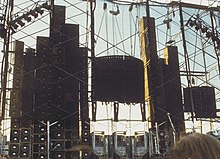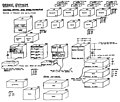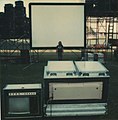
A movie projector is an opto-mechanical device for displaying motion picture film by projecting it onto a screen. Most of the optical and mechanical elements, except for the illumination and sound devices, are present in movie cameras. Modern movie projectors are specially built video projectors.

A slide show (slideshow) is a presentation of a series of still images (slides) on a projection screen or electronic display device, typically in a prearranged sequence. The changes may be automatic and at regular intervals or they may be manually controlled by a presenter or the viewer. Slide shows originally consisted of a series of individual photographic slides projected onto a screen with a slide projector. When referring to the video or computer-based visual equivalent, in which the slides are not individual physical objects.

A sound reinforcement system is the combination of microphones, signal processors, amplifiers, and loudspeakers in enclosures all controlled by a mixing console that makes live or pre-recorded sounds louder and may also distribute those sounds to a larger or more distant audience. In many situations, a sound reinforcement system is also used to enhance or alter the sound of the sources on the stage, typically by using electronic effects, such as reverb, as opposed to simply amplifying the sources unaltered.

Powered speakers, also known as self-powered speakers and active speakers, are loudspeakers that have built-in amplifiers. Powered speakers are used in a range of settings, including in sound reinforcement systems, both for the main speakers facing the audience and the monitor speakers facing the performers; by DJs performing at dance events and raves; in private homes as part of hi-fi or home cinema audio systems and as computer speakers. They can be connected directly to a mixing console or other low-level audio signal source without the need for an external amplifier. Some active speakers designed for sound reinforcement system use have an onboard mixing console and microphone preamplifier, which enables microphones to be connected directly to the speaker.


Professional audio, abbreviated as pro audio, refers to both an activity and a category of high-quality, studio-grade audio equipment. Typically it encompasses sound recording, sound reinforcement system setup and audio mixing, and studio music production by trained sound engineers, audio engineers, record producers, and audio technicians who work in live event support and recording using mixing consoles, recording equipment and sound reinforcement systems. Professional audio is differentiated from consumer- or home-oriented audio, which are typically geared toward listening in a non-commercial environment.

Stage lighting instruments are used in stage lighting to illuminate theatrical productions, concerts, and other performances taking place in live performance venues. They are also used to light television studios and sound stages.
Meyer Sound Laboratories is an American company based in Berkeley, California that manufactures self-powered loudspeakers, multichannel audio show control systems, electroacoustic architecture, and audio analysis tools for the professional sound reinforcement, fixed installation, and sound recording industries.

Audiovisual (AV) is electronic media possessing both a sound and a visual component, such as slide-tape presentations, films, television programs, corporate conferencing, church services, and live theater productions.
Acoustic enhancement is a subtle type of sound reinforcement system used to augment direct, reflected, or reverberant sound. While sound reinforcement systems are usually used to increase the sound level of the sound source, acoustic enhancement systems are typically used to increase the acoustic energy in the venue in a manner that is not noticed by the audience. The correctly installed systems replicate the desired acoustics of early reflections and reverberation from a room that is properly designed for Acoustic Music. An additional benefit of these systems is that the room acoustics can be changed or adjusted to be matched to the type of performance. The use of Acoustic Enhancement as Electronic Architecture offers a good solution for multi-use performance halls that need to be "dead" for amplified music, and are used occasionally for acoustic performances. These systems are often associated with acoustic sound sources like a chamber orchestra, symphony orchestra, or opera, but have also found acceptance in a variety of applications and venues that include rehearsal rooms, recording facilities conference rooms, sound stages, sports arenas, and outdoor venues.
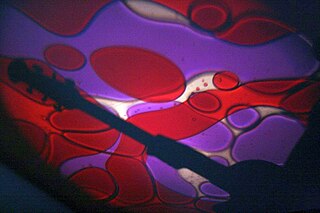
Liquid light shows are a form of light art that surfaced in the early 1960s as accompaniment to electronic music and avant-garde theatre performances. They were later adapted for performances of rock or psychedelic music.
A Linnebach lantern or Linnebach projector is a lensless projection system used in theatrical productions. It was developed by Adolf Linnebach (1876-1963) around 1917 and was used in North American theatres in the 1920s. Since the middle of the 20th century, it has largely been replaced by other projection technologies.
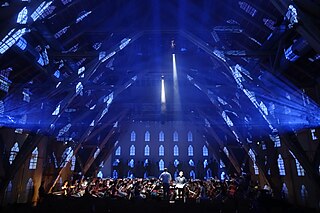
Video design or projection design is a creative field of stagecraft. It is concerned with the creation and integration of film, motion graphics and live camera feed into the fields of theatre, opera, dance, fashion shows, concerts and other live events. Video design has only recently gained recognition as a separate creative field. For instance, United Scenic Artists' Local 829, the union that represents designers and scenic artists in the US entertainment industry, only added the Projection Designer membership category in 2007. Prior to this, the responsibilities of video design would often be taken on by a scenic designer or lighting designer. A person who practices the art of video design is often known as a Video Designer. However, naming conventions vary around the world, and so practitioners may also be credited as Projection Designer, "Media Designer", Cinematographer or Video Director. As a relatively new field of stagecraft, practitioners create their own definitions, rules and techniques.
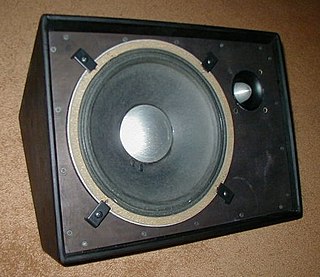
A stage monitor system is a set of performer-facing loudspeakers called monitor speakers, stage monitors, floor monitors, wedges, or foldbacks on stage during live music performances in which a sound reinforcement system is used to amplify a performance for the audience. The monitor system allows musicians to hear themselves and fellow band members clearly.
Articles related to the field of motion pictures include:
The following outline is provided as an overview of and topical guide to stagecraft:

A projector or image projector is an optical device that projects an image onto a surface, commonly a projection screen. Most projectors create an image by shining a light through a small transparent lens, but some newer types of projectors can project the image directly, by using lasers. A virtual retinal display, or retinal projector, is a projector that projects an image directly on the retina instead of using an external projection screen.

McCune Audio Video Lighting is an American company based in South San Francisco, California, with offices in Monterey and Anaheim. It is one of the oldest and largest audio visual rental and sound services in the U.S. McCune was founded in 1932 by Harry McCune Sr, McCune AVL provides audio, lighting and high-definition video services to events as varied as outdoor festivals such as the Monterey Jazz Festival, and the Bohemian Grove, and to arena conferences such as TED.
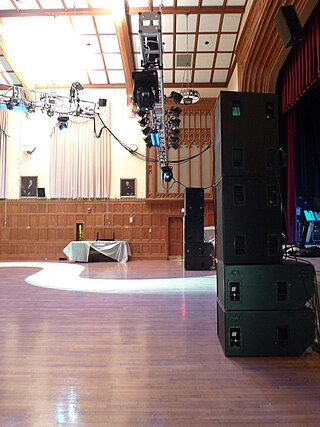
A professional audio store is a retail business that sells, and in many cases rents, sound reinforcement system equipment and PA system components used in music concerts, live shows, dance parties and speaking events. This equipment typically includes microphones, power amplifiers, electronic effects units, speaker enclosures, monitor speakers, subwoofers and audio consoles (mixers). Some professional audio stores also sell sound recording equipment, DJ equipment, lighting equipment used in nightclubs and concerts and video equipment used in events, such as video projectors and screens. Some professional audio stores rent "backline" equipment used in rock and pop shows, such as stage pianos and bass amplifiers. While professional audio stores typically focus on selling new merchandise, some stores also sell used equipment, which is often the equipment that the company has previously rented out for shows and events.
Abe John Jacob is an American sound designer and audio engineer. Called the "Godfather of Sound", Jacob greatly influenced the design of sound reinforcement in modern musical theatre, and was one of the first persons credited in the role of sound designer on Broadway, with a sound designer credit in Playbill in 1971.




